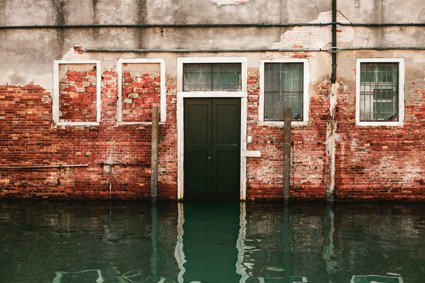
Getting the message across
This lesson is about flood warnings
Key questions
How do we know when a flood is coming?
How are flood warnings issued?
How do we know when a flood is coming?
Since the mid-1900s, scientists' ability to predict the arrival of extremely wet or dry weather has improved for many reasons:
-
Satellite photographs. Satellite images show weather systems developing long before they make landfall - often given forecasters several days' notice of heavy rain arriving
-
Soil moisture monitoring. If soil is wet from previous storms then new rain cannot soak in and will flow fast over the land to the river, making the flooding even worse. Data can be sent from the monitoring equipment by radio, keeping scientists up to date with what's happening
-
Mapping. Maps show how steep the gradient of the land is. This gives scientists an idea of how quickly rain will flow downhill. Geology maps show what rocks are present, and whether water can soak in
-
Hydrograph calculations. Once scientists know how much rain is coming, the gradient of the slopes and the moisture content of the soil, they can compute hydrographs to show the height the river level is likely to reach
How are flood warnings issued?
Floods can strike at any time, often with little notice. The Environment Agency aims to give up to two hours warning to homeowners before the onset of a flood, but sometimes this is not possible. Environment Agency warning messages only cover the risk of flooding from rivers and coasts. Flash floods and flooding from sewers and drains caused by heavy rain are not covered.
Traditionally, flood warnings were given through visits from flood wardens, door knocking by neighbours, sirens, television/radio broadcasts and mobile loudhailers on vehicles. Today, the Environment Agent issue warnings in a number of different ways:
-
Phone - A recorded message will tell you if a flood warning has been issued for your area
-
Email/fax - A flood warning message will be sent along with advice on what to do
-
SMS text - A flood warning message will be sent
-
Pager - You will be sent the Floodline number to call for further information
Different methods of receiving flood warnings will be suitable for different people. In the event of a flood, it is particularly important to consider vulnerable populations, for example, visually impaired people, hard-of-hearing people, elderly and disabled people, and children. Visually impaired people must be able to hear warnings. They may not watch television or be able to see rising waters. Braille printers are available for PCs meaning that email alerts have the potential to work. Hard of hearing people must be able to see warnings. They may not listen to the radio or hear sirens or door knocking. They can receive email or SMS warnings, or read subtitles on the television. People with impaired mobility must receive warnings well in advance of flooding as they may require additional time to evacuate. Many people, perhaps particularly the elderly, low income earners or the homeless may not own expensive communication devices like mobile phones, PCs and perhaps even televisions and telephones. These people are harder to warn, as are non-English speaking groups who may not understand warnings in English.
You can refresh your memory of the story of the boy who cried wolf by visiting the Story Arts website. Agencies need to strike a balance between ensuring that people are given enough warning about a potential flood and giving out too many warnings (many of which result in nothing). People are more likely to take notice of warnings when they happen infrequently and are accurate.
Starter
He is behind you
How do we know when danger is looking over our shoulder? The he is behind you presentation introduces you to some of the methods forecasters use to predict flooding. At the end of the presentation, there are some links to websites that you can visit to see if any flood or extreme weather warnings have been issued for your area.
But even when scientists have information telling them a flood is coming, how do we make sure that the public receive the warning?
How will we know that 'he is behind you' if we do not actually hear anyone shouting it at us?
Main Activity
Something old, something new
There are a number of flood warning techniques that are in use. Some are traditional, meaning that they have been around for many years. Others are more ‘hi-tech', using digital technology, and these have only been around for a few years.
In the sending the message sorting activity, you have to divide the different techniques into two piles: ‘old' and ‘new'.
Helping vulnerable groups
Why might some flood warning methods suit some types of people better than others? Complete the sending the message worksheet, which encourages you to think about the best method for alerting different people about flooding. When you've finished, ask your teacher for the answers.
Plenary
The sending the message presentation gives you a summary of what you have learnt this lesson.
What lessons can be learnt from Aesop's famous fable about the boy who cried wolf? (Refresh your memory of the story). How often should flood warnings be issued if we don't want people to start ignoring them?
File nameFiles
File type
Size
Download